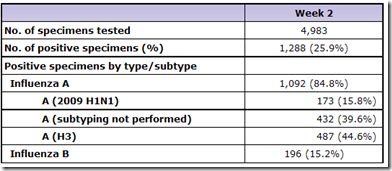# 5251
The latest FluWatch and FluView numbers were released on Friday and once again we have a mixed bag; while some activity indicators have declined, others are showing strength.
Unlike the UK and most of Europe, which have dealt primarily with the 2009 H1N1 virus – most of our identified influenza A activity stems from the recently emerged Perth A/H3N2 virus.
Starting with Canada’s weekly FluWatch report, we find that while several activity indicators have dropped, the percentage of samples testing positive for the 2009 H1N1 virus has nearly doubled since week 1.
January 9 to January 15, 2011 (Week 2)
Posted 2011-01-21
Summary of FluWatch Findings for the Week ending January 15, 2011
- During week 02 several indicators of influenza activity have decreased across the country: the number of regions reporting widespread and localized influenza activity, the number of outbreaks, the percentage of specimens testing positive for influenza, the ILI consultation rate and the number of paediatric and adult hospitalizations.
- Since the beginning of the season, 91.1% of the subtyped positive influenza A specimens were influenza A/H3N2.In week 02, detections of pandemic H1N1 2009 increased to 15.5% of all subtyped influenza A specimens, compared to 8.5% in week 01.
Overall Influenza Summary – Week 2 (January 9 to 15, 2011)
In week 02, one region in ON reported widespread influenza activity, 11 regions reported localized activity (in AB(1), MB(1), ON(5), QC(3) & PE(1)), 25 regions reported sporadic activity (in all provinces and territories except YK, NL and PE) and 16 regions presented no activity. No data was available for NU at time of report. (See Activity level Map).
Compared to the previous 2 weeks (weeks 52 & 01), 11 regions reported increased influenza activity, one region reported decreased activity, and 19 regions maintained a stable level of influenza activity (sporadic or higher).
During week 02, 27 new ILI/influenza outbreaks were reported: 22 in long-term care facilities (LTCF) in AB(1), MB(1), ON(5), QC(14) and NS(1); 3 outbreaks in hospitals in ON; one outbreaks in other facilities/settings in PE, and a school outbreak in NS.
Moving on to the CDC’s weekly FluView surveillance report, we find that influenza activity is down a little over the previous week, although the CDC cautions that we have not likely reached the peak of our flu season.
Interestingly – while the A/H3N2 strain remains largely dominant - the percentage of samples testing positive for the 2009 H1N1 virus have (as was also reported in Canada) doubled over the past week.
Whether this indicates some kind of longer term trend is something we’ll simply have to wait to see.
2010-2011 Influenza Season Week 2 ending January 15, 2011
All data are preliminary and may change as more reports are received.
Synopsis:
During week 2 (January 9-25, 2011), influenza activity in the United States decreased in several indicators, but it is unlikely that influenza activity for this season has peaked.
- Of the 4,983 specimens tested by U.S. World Health Organization (WHO) and National Respiratory and Enteric Virus Surveillance System (NREVSS) collaborating laboratories and reported to CDC/Influenza Division, 1,288 (25.9%) were positive for influenza.
- The proportion of deaths attributed to pneumonia and influenza (P&I) was below the epidemic threshold.
- Two influenza-associated pediatric deaths were reported. One of these deaths was associated with an influenza A (H3) virus and one was associated with an influenza A virus for which the subtype was not determined.
- The proportion of outpatient visits for influenza-like illness (ILI) was 2.9%, which is above the national baseline of 2.5%. Three of the 10 regions (Regions 2, 4, and 5) reported ILI above region-specific baseline levels. Four states experienced high ILI activity, New York City and nine states experienced moderate ILI activity, seven states experienced low ILI activity, 30 states experienced minimal ILI activity, and data were insufficient from the District of Columbia.
- The geographic spread of influenza in 17 states was reported as widespread; 15 states reported regional influenza activity; the District of Columbia and 12 states reported local influenza activity, and Guam, Puerto Rico, the U.S. Virgin Islands, and six states reported sporadic influenza activity.
U.S. Virologic Surveillance:
WHO and NREVSS collaborating laboratories located in all 50 states and Washington D.C. report to CDC the number of respiratory specimens tested for influenza and the number positive by influenza type and subtype. The results of tests performed during the current week are summarized in the table below.

Antigenic Characterization:
CDC has antigenically characterized 257 influenza viruses [29 2009 influenza A (H1N1) viruses, 137 influenza A (H3N2) viruses, and 122 influenza B viruses] collected by U.S. laboratories since October 1, 2010.
2009 Influenza A (H1N1) [29]
- All 29 were characterized as A/California/7/2009-like, the influenza A (H1N1) component of the 2010-11 influenza vaccine for the Northern Hemisphere.
Influenza A (H3N2) [137]
- All 137 were characterized as A/Perth/16/2009-like, the influenza A (H3N2) component of the 2010-11 influenza vaccine for the Northern Hemisphere.
Influenza B (B/Victoria/02/87 and B/Yamagata/16/88 lineages) [122]
Victoria Lineage [112]- Eight-three (92%) of the 122 influenza B viruses tested belong to the B/Victoria lineage of viruses and were characterized as B/Brisbane/60/2008-like, the recommended influenza B component for the 2010-11 Northern Hemisphere influenza vaccine.
Yamagata Lineage [10]
- Eight (8%) of the 122 viruses were identified as belonging to the B/Yamagata lineage of viruses.
Pneumonia and Influenza (P&I) Mortality Surveillance
During week 2, 7.5% of all deaths reported through the 122-Cities Mortality Reporting System were due to P&I. This percentage was below the epidemic threshold of 7.8% for week 2.
With both weekly reports, I’ve only provided the summaries and a few excerpts. Follow the links to read them in their entirety.

